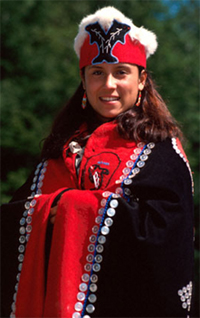Introduction
Culture
Alaska natives divide into three broad
groups: Indians, originally from the
southeast and interior; Aleuts, on
the Alaska Peninsula; and the Inuits,
mostly concentrated along the mainland
coast. Languages separate these people
into distinct groups. Aleuts speak
Aleut. Inuits speak Chugach, Inupiat,
Koniag, and Yupik. Indians speak Athapaskan,
Eeyak, Haida, Tsimahian, and Tlingit.
More than 14 native Alaska languages
are still spoken throughout the state.
The symbol of Alaskan aborigines,
the totem pole, once stood over Tlingit
and Haida communities in southeast
Alaska; now many of these hand-carved
cedar poles reside in museums and
parks. The decorative family crests
and mythical beings either protected
the dead or promoted the living.
 The
Athapaskans first crossed the land
bridge across the Bering Strait at
least 12,000 years ago. This first
wave of migration followed mastodon,
mammoth, and caribou herds across
the Bering. The Athapaskans fashioned
crude tools from the raw copper they
found along the way. Over time, they
reached the coast. The Athapaskan-related
Tlingits wandered down the Nass River
not far from Prince Rupert and then
headed north through southeast Alaska.
They harvested fish and other seafood
from the coastal waters. The forests
yielded cedar logs for community houses,
totem poles, and dugout canoes. To
this day, from interior Alaska to
the American Southwest, the Navajo
and Apache peoples still speak the
Athapaskan language or derivatives
thereof. The
Athapaskans first crossed the land
bridge across the Bering Strait at
least 12,000 years ago. This first
wave of migration followed mastodon,
mammoth, and caribou herds across
the Bering. The Athapaskans fashioned
crude tools from the raw copper they
found along the way. Over time, they
reached the coast. The Athapaskan-related
Tlingits wandered down the Nass River
not far from Prince Rupert and then
headed north through southeast Alaska.
They harvested fish and other seafood
from the coastal waters. The forests
yielded cedar logs for community houses,
totem poles, and dugout canoes. To
this day, from interior Alaska to
the American Southwest, the Navajo
and Apache peoples still speak the
Athapaskan language or derivatives
thereof.
Today, Alaska remains as diversely
populated as its dramatic topography.
On Kodiak Island, Alaska cowboys ride
a well-worn path. For decades a handful
of hardy ranchers tried to raise cattle
on the Island of the Bears. When cowhands
blamed hungry bears for missing calves,
ranchers turned to hunters to rid
them of the problem. The U.S. government
sided with the bears and established
Kodiak National Wildlife Refuge to
protect the native predators. Some
ranchers are now switching to bison,
a less vulnerable livestock.
The U.S. government's most sweeping
agreement with native peoples took
place in 1971. The act established
native regional corporations and village
corporations to manage money and land,
amounting to 44 million acres and
nearly a billion dollars. The negotiation
occurred before the 1968 oil discovery
at Prudhoe Bay could be exploited.
Roughnecks brought a new wave of immigrants
to Alaska throughout the 1970s. The
production of Prudhoe Bay oil began
in 1977; that same year, men started
constructing a natural gas pipeline
that would cross the state. Many people
remained in Alaska after the boom.
In 1976, before he left office, President
Jimmy Carter restructured over 56
million acres of Alaska's federal
lands to include them in the national
park system. The parks encouraged
recreation in Alaska's great expanse.
Most Alaska towns attract hardscrabble
people who retain a bit of the pioneer's
will and the Indians' spirit. Some
joke that the local logo ought to
show a blue pickup truck with a Siberian
husky in it. But much of Alaska is
inaccessible by road and many people
travel by floatplane, bush plane,
and boat. Along the coast, fishing
propels the economy; elsewhere, oil
powers it. Everywhere, people rely
on each other to get through the long,
dark winter months.
|

